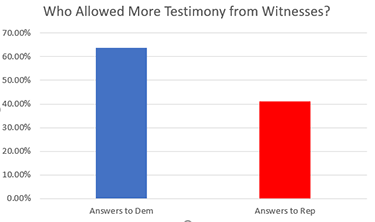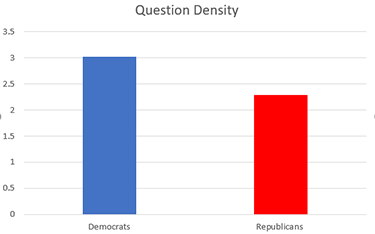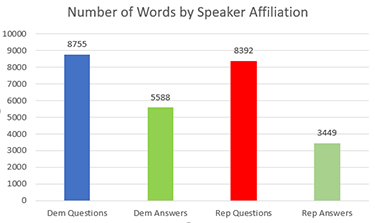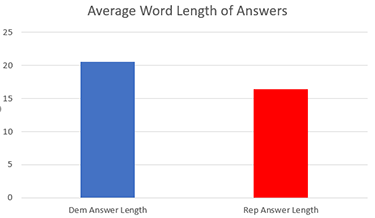Bad Faith: GOP, Impeachment and Simple Statistics

Ostensibly, the purpose of public impeachment hearings is to collect testimony from witnesses to determine whether the President has committed impeachable offenses. Unfortunately, these types of public affairs tend to become political theater, as individuals from both parties try to grandstand rather than conduct a proper investigation. Once again, legislators have come under attack for grandstanding rather than properly questioning the witnesses. But is this a fair characterization of the Republican representations? Well, luckily we can use some fairly simple statistics to compare the behavior of the Democrat and Republican representatives in order to determine whether one is acting in bad faith.
If the goal of the hearings is to extract testimony from witnesses, then we have at our hands a few simple metrics which describe how effective each side is at eliciting testimony.
- Question Density: To what degree did a political party’s representatives ask questions vs. make statements.
- Asker-Answerer Ratio: To what degree did a political party’s representatives spend their time speaking vs. their witnesses.
- Answer Length: To what degree did a political party’s representatives allow the witnesses to give expository answers vs. yes/no leading questions.
Thanks to the good folks over at rev.com, we have a handwritten transcript of the Taylor/Kent testimony on Wednesday, making this simple analysis possible.
Question Density
How often did each party’s representatives use their time to ask questions of the witnesses? How often did they use their time to make statements? The higher the question density, the more engagement with the witness.
The question density for Democrats was 3.01 vs Republicans at 2.28 (measured as number of questions asked vs words used). Thus, for our first metric, it is clear that Democrats were more intent on hearing what the witnesses had to say than the Republicans.
Asker-Answer
The next metric we can use to determine whether the investigators are grandstanding rather than soliciting testimony is simply to compare the amount of time they spend talking vs. their witnesses. Expressed as a function of number of words used, this also gets at whether the questioner is asking leading questions.
As we can see, the witnesses gave 60% longer responses relative to their Democrat questions than Republicans questions, even though Republicans spent roughly identical lengths of “questioning”. This indicates that the Republicans were either using their time to make statements or to ask leading questions that only deliver a yes/no answer.
Answer Length
Finally, we can look at the simple average length of answers to questions by Democrats and Republicans respectively.
Answers to Democrat questions were 20.54 in length on average, while answers to Republican questions were 16.41. While that might not seem like a lot, over the course of several hours of testimony, it adds up.
Concluding Thoughts
In all three simple areas of analysis, Republicans spent much more time making statements than actually trying to solicit testimony from witnesses. This is indicative of a hearing where one group is interested in bringing out testimony while the other is interested in suppressing testimony. The Republicans in the House are acting in bad faith. If they are right, the truth shall set them free. But we can’t know the truth without asking questions, something Republicans seem very hesitant to do.





Recent Comments